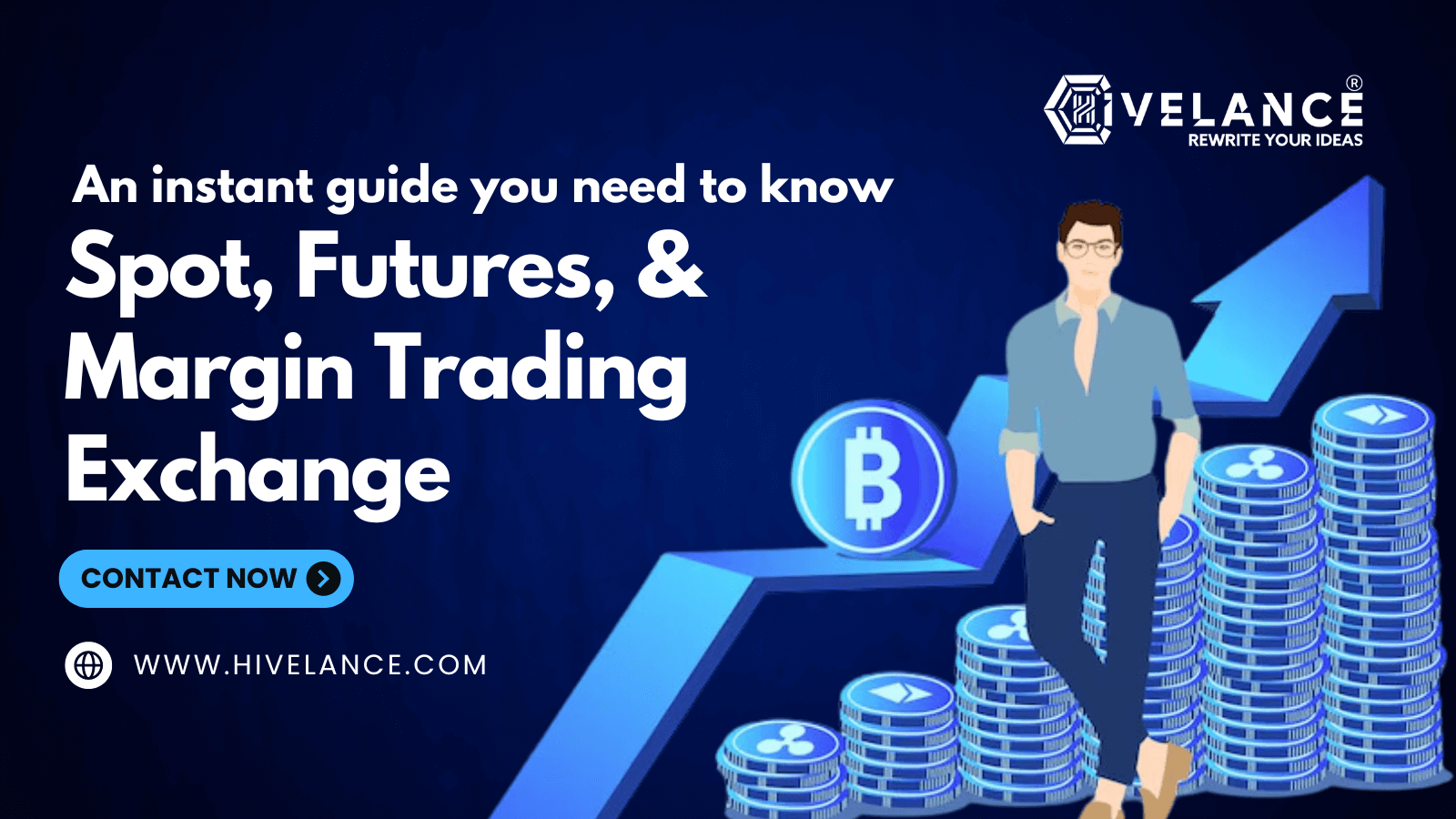When the traders swarm various crypto assets or contracts from various outlets, including spot, derivatives futures, and margin trading platforms, the scene can resemble a busy market. Market penetration is determined by the prices. According to entrepreneurs, the crypto market is comparable to a digital battlefield where businesses are fighting for customers and attention.
It's critical to comprehend the subtleties and distinctions between these markets before business owners brandish their metaphorical swords in the turbulent cryptocurrency space defined by the 2024 Bitcoin Halving and the craze for crypto ETFs. This blog is your best bet, when it comes to learning about margin trading, futures, and spot trading cryptocurrency exchange.
Spot Trading: What is it?
When it comes to buying and selling in a typical market, spot trading is the most easy. A platform for direct cryptocurrency buying and selling at market rates is provided by this kind of exchange to dealers. These exchanges provide an easy, low-risk entrance point for novice cryptocurrency wranglers, allowing them to experiment and grow their portfolio at their own speed.
In contrast to its other counterparts, such as derivatives and margin trading exchanges. Traders can buy cryptocurrency outright, receive it immediately, and store it in their exchange wallet for as long as they like. The manner in which an exchange provides spot exchange capabilities determines the specifics of the buying and selling operation.
Key takeaways
- Securities traded for instant delivery in the market on a designated date are known as spot trades.
- Spot trades can involve the purchase or sale of commodities, financial instruments, or foreign currency.
- A "spot price" and a "futures or forward price" are quoted for many assets.
- The majority of spot market deals are settled on a T+2 basis.
- Spot market trades can happen over the counter or on an exchange.
Features of Spot Trading Exchanges
These platforms, which provide a basic range of services like the following, are the first that most traders meet in the cryptocurrency space.
- Instantaneous ownership transfer
- Interface is easy to use
- A large assortment of cryptocurrencies
- Elevated liquidity
- Safety precautions
- Minimal trading costs
- Compatibility for mobile devices
- sophisticated charting instruments
- Quick transaction processing and attentive client service
- Adherence to regulations
Advantages of Spot Trading Exchange Development
- A simple revenue model that allows for innovation and growth
- Demands full payment up front and gives businesses instant liquidity
- They are less complicated to design than futures, leverage, and margin trading exchanges because they don't have any extra complexity like expiration dates or leverage.
- Adding a spot exchange to your current financial services will help you reach a wider audience and draw in new clientele.
- A reputable spot trading exchange can benefit from the rising cryptocurrency industry by utilizing transaction fees, a straightforward revenue model, to generate a great deal of cash.
Futures Trading: What is precisely known?
Prior to entering the futures market, one needs to have a basic understanding of what futures are, just as knowledge of leverage was necessary to comprehend margin exchanges. Futures are intricate agreements that derive their worth from underlying assets. You don't purchase or sell digital assets directly, just like on a spot or margin trading market. Rather, it is an arrangement that implies contracts to buy or sell bitcoins at a fixed price at a later time. Without holding the underlying asset, traders make predictions about how the prices of cryptocurrencies will change in the future and profit from both upward and downward price swings.
Key takeaways
- Standardized contracts to buy or sell assets at future dates are traded in the futures market for hedging and speculation reasons. Traders must adjust their strategy to shifting market conditions and decide whether to go long or short based on expected market changes.
- Futures traders utilize a variety of trading methods to profit from price movements and market trends, including trend following, breakout trading, range trading, mean reversion, momentum, news, spread trading, pullback, crude oil, and index trading.
- An effective trading strategy that strikes a balance between objectives and risk tolerance, together with technical and fundamental research, stop-loss orders, diversification, and other risk management tools, are all essential components of a profitable futures trading strategy.
Ideal elements for Futures Trading exchange
- Varying lengths of contracts
- Elevated liquidity
- Sophisticated trading interface Utilize options
- Precise conditions of the contract
- Current market information
- Tools for risk management
- Dependable order matching engine
- Competitive rates
- Adherence to regulations
Pros of Futures Trading Exchange
- Due to its ability to allow for both long and short positions and the ability to profit from price changes in both directions, futures contracts are becoming more and more popular.
- Distinctive attributes set exchanges apart from the competition and draw in a devoted user base looking for advanced trading capabilities.
- draws seasoned and high-rolling traders in search of a variety of investment instruments and the possibility of increased profits.
- Futures trading exchange development can broaden the user base of already-existing exchanges.
- Due to its increasing popularity and attractive revenue streams from listing and transaction fees, it offers a profitable possibility.
Margin trading: What does it mean?
Greater earnings necessitate greater capital. Leverage increases traders' profitability by adding additional funds to the trading process. In order to enter a larger trade than you have already set aside for a transaction, it can be described as a loan acquired from the market or borrowed via a leverage and margin trading exchange platform.
Traders eventually repay the borrowed funds and realize profits or losses from the turbulent cryptocurrency market after strengthening their position. Therefore, the market is riskier for traders than spot markets because leverage and margin trading exchange platforms can enable them to multiply their gains or losses.
Key Considerations
- The money borrowed from a broker to buy an investment is known as the margin, which is the difference between the investment's entire value and the loan amount.
- Margin trading is the process of trading a financial asset that serves as collateral for a broker loan, utilizing money borrowed from the broker.
- An investor may use the current cash or securities in their margin account, which is a regular brokerage account, as security for a loan.
- Both gains and losses will typically be amplified by the leverage that comes with margin. A margin call could force your broker to sell securities without your permission if there is a loss.
Stand alone features for Margin Trading:
- Strong risk control
- Make use of options
- Availability of margin funds
- competitive rates of interest
- Various trading pairs
- Protection during liquidation
- Tools for real-time monitoring
- Clear and concise cost schedule
- Adaptable order formats
- Resources for education
Pros of Margin Trading Exchange
- A unique element that helps exchanges differentiate themselves from its spot-only rivals
- Entices retail traders who wish to increase their profits on a small investment
- Ideal for drawing in large numbers of traders in search of higher returns, which can result in Increased earnings from transaction costs, interest on loans, liquidation costs, etc.
- Exchanges that offer margin trading services target a certain market and draw in a devoted following of users.
- Leverage positions allow for increased trading activity and user involvement, which increases exchange volume and platform liquidity.
- Allows for the incorporation of cutting-edge features including risk assessment calculators, automated margin management tools, and exclusive margin lending possibilities.
Wrapping up
With cryptocurrency trading, investors and business owners can interact with the market through a variety of channels, including margin trading, futures trading, and spot trading. Comprehending the distinctions and subtleties among them can enable novices to make knowledgeable trading and business choices and adeptly maneuver through the intricacies of the ever-changing bitcoin landscape.
Hivelance specializes in creating successful cryptocurrency exchanges. We can help you since we have unmatched knowledge and experience in the field, whether your goal is to create a fantastic margin trading exchange, an amazing spot trading experience, or all three. Keep ahead of the curve by utilizing our solutions.
Immediately share your specific needs!
 Trends
Trends
 Crypto
Crypto
 Web 3.0
Web 3.0
 AI
AI
 Blockchain
Blockchain
 Fintech
Fintech
 Company
Company


















